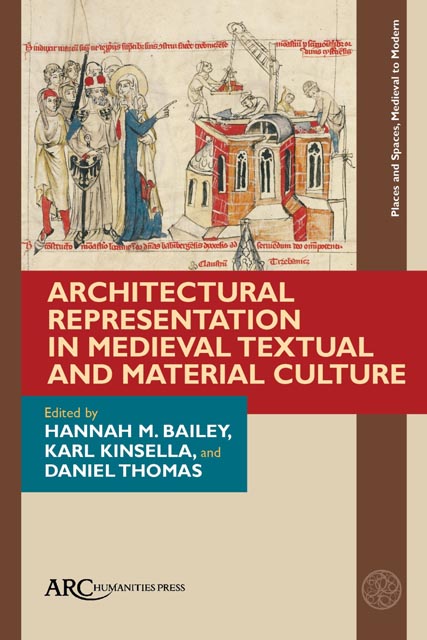Book contents
- Frontmatter
- Contents
- List of Illustrations
- Acknowledgements
- Introduction: Architectural Representation in Medieval Textual and Material Culture
- Chapter 1 Designing the Regensburg Spire and Harburg Tabernacle: The Geometries of Two Great German Gothic Drawings
- Chapter 2 Wilfrid’s Restoration of the Church at York and the Permanence of Sacred Buildings in Post-Conversion Northumbria
- Chapter 3 Heaven-Roofs and Holy Altars: Envisioning a Seventh-Century English Church in Aldhelm’s Carmina Ecclesiastica 3
- Chapter 4 “Beaten Down and Built Anew”: Saint Erkenwald and Old St. Paul’s
- Chapter 5 Castle Viewscapes in Literature and Landscapes
- Chapter 6 Architectural Alignment in Early Medieval English Settlements: Zoning, Meaning, and Function
- Chapter 7 Underneath the Arches: Peter of Eboli and the Orderly Architecture of Norman Sicily
- Chapter 8 Reading the Saint’s Church: A Northern Perspective
- Select Bibliography
- Index
Chapter 6 - Architectural Alignment in Early Medieval English Settlements: Zoning, Meaning, and Function
Published online by Cambridge University Press: 16 November 2023
- Frontmatter
- Contents
- List of Illustrations
- Acknowledgements
- Introduction: Architectural Representation in Medieval Textual and Material Culture
- Chapter 1 Designing the Regensburg Spire and Harburg Tabernacle: The Geometries of Two Great German Gothic Drawings
- Chapter 2 Wilfrid’s Restoration of the Church at York and the Permanence of Sacred Buildings in Post-Conversion Northumbria
- Chapter 3 Heaven-Roofs and Holy Altars: Envisioning a Seventh-Century English Church in Aldhelm’s Carmina Ecclesiastica 3
- Chapter 4 “Beaten Down and Built Anew”: Saint Erkenwald and Old St. Paul’s
- Chapter 5 Castle Viewscapes in Literature and Landscapes
- Chapter 6 Architectural Alignment in Early Medieval English Settlements: Zoning, Meaning, and Function
- Chapter 7 Underneath the Arches: Peter of Eboli and the Orderly Architecture of Norman Sicily
- Chapter 8 Reading the Saint’s Church: A Northern Perspective
- Select Bibliography
- Index
Summary
The architect ure of the early medieval period in England is known mostly through archaeology rather than standing buildings. While this limits our direct engagement with material evidence, archaeological investigation has made it possible to see a broader planning context of individual buildings, to reconstruct the relationships between the buildings within settlements, and to explore what those relationships may have meant to the people using these buildings. My approach is based on a detailed examination of archaeological evidence for sixth-and seventh-century phases of occupation at a number of well-recorded sites, followed by an observation of spatial relationships between the structures and an assessment of recurring elements and similarities in planning principles. This work leads to a proposal that there is an intrinsic link between the grouping of buildings, frequently marked by distinctive axial arrangements, and the recurring functions of these groups, including those associated with authority and religious ritual, as well as the more mundane ones focusing on serving the settlement.
The inherent connection between the structure of the spaces we live in and the structure of our lives is best formulated in Pierre Bourdieu's seminal essay on the ways the Berber house mirrors Berber social order and fundamental existential concepts. In the essay, the Berber house is seen as a model of architectural expression built on dichotomies between light and dark, life and death, the domestic and the public, the masculine and the feminine—the categories that encompass everyday functions, religious and cultural concepts, as well as fundamental cosmological paradigms. The geometry of the house is mapped onto the ideas larger than the house itself. In the same way, any form of geometry we intentionally choose to impose on our dwellings and social environment can be read as a form of identification or a signifier of our relationships with the surrounding world and with each other, beyond one house, but within and across a settlement and different social circles. The investigation of such forms of geometry in the context of early medieval England reveals two critical aspects in the design of the settlements of this period: linearity and zoning.
Linearity, or alignment, is the arrangement of two or more buildings in one line on the same axis. It was prominent in the built environment in England starting around 600 and continuing through the pre-Conquest period.
- Type
- Chapter
- Information
- Publisher: Amsterdam University PressPrint publication year: 2023



